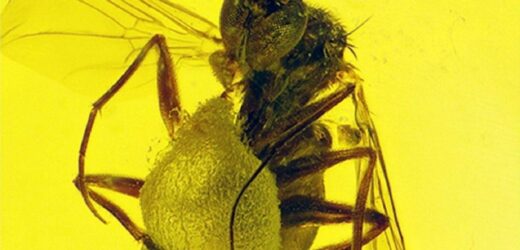Palaeontologist identifies 'enormous' ancient ichthyosaur fossil
We use your sign-up to provide content in ways you’ve consented to and to improve our understanding of you. This may include adverts from us and 3rd parties based on our understanding. You can unsubscribe at any time. More info
In the animal kingdom, nuptial gifts are objects given by a male to a female during courtship and mating rituals. They can take a variety of forms, from pure tokens like fragments of leaves to edible items like small prey, salivary secretions or even the male’s own body parts to eat or blood to drink. In some cases, prey items are presented wrapped up in silk, trapped in frothy mucus balloons or even, in the case of a bird called the great grey shrike, skewered on thorns like a mouse shish kebab. Gifts are intended to either make the female more receptive, to provide them with nutrients or defensive compounds that improve their fitness — or, in some cases, to distract the females so the males can mate with them without getting eaten themselves.
In their study, entomologist Dr Chufei Tang of China’s Jiangsu Academy of Agricultural Sciences and her colleagues present the first-ever discovery of a nuptial gift preserved in the fossil record.
Preserved in amber, the gift-offering specimen — a male fly of the genus Alavesia, in the superfamily Empidoidea — was collected from the Hukawng Valley in northern Myanmar’s Kachin Province.
Other pieces of amber from this locality have been radiometrically dated to around 99 million years ago, during the mid-Cretaceous Period.
The gift grasped between the fly’s legs comes in the form of an empty, frothy balloon made of mucus around one millimetre in diameter — about as long as the insect’s abdomen — secreted from the male’s salivary glands.
Given that no residue from the balloon could be seen on its body, the researchers believe that at the time the fly became trapped in resin the gift was fully formed.


The researchers said: “Nuptial gift-giving is one of the most remarkable traits to have evolved among animal mating systems, and has brought about numerous hypotheses regarding their evolution and influence.
“Yet, their study has been confined to the modern fauna owing to their ephemeral nature and lack of traces on the environment suitable for preservation.”
“Here we report the first paleontological and earliest evidence of nuptial gift-giving behaviour from a male fly of Alavesia that is an obligate flower visitor.”
This specimen, they added, “demonstrates the antiquity of this behaviour, its occurrence in early diverging lineages of Empidoidea, and its maintenance over 99 million years”.


According to the team, it is believed that “initially, the gift of empidoid flies was a bare prey item, since hitherto nuptial gift-giving was only observed in raptorial groups in which females are inactive in hunting and could only get such nutrients from the offering of males.
“From this initial point, complexities to the nature of the gifts evolved.”
Wrapping the gift up like a present, the researchers explained, would have helped the male flies remain in control of the gift during courtship and copulation, thereby reducing the risk of the female flies re-mating.
They added: “The ultimate result is the formation of the balloon as a packaging system for the prey item.”
From here, some males may have decided to cut corners by presenting empty balloons — attempting, as the team put it, to “deceive females into mating despite minimal investment on the part of the male”.
Alternatively, the researchers propose, it could be that the giving of empty balloons evolved first — as consumption of the mucus alone may provide nutrients for the female flies.
In this scenario, the inclusion of prey in the balloon as an added treat would have been derived later in time.
DON’T MISS:
Joe Biden lends name to new species of extinct vampire-like squid [REPORT]
Attenborough stunned as fossil found from THE DAY the dinosaurs died [INSIGHT]
Charles Darwin mystery solved after 140 years with stunning find [ANALYSIS]

To get a closer look at the fossilised fly and its gift, the researcher first cut the amber specimen using a mini table saw.
They then polished the cut section with emery sandpaper and polished it to enable the clearest possible view of the included specimen.
The fossil was then both photographed down a microscope and also imaged via so-called epifluorescence microscopy, in which a specimen is subjected to light of a specific wavelength that excites it, causing it to emit its own light in turn.
With the study complete, the fossil specimen has been deposited in the collections of the Entomological Museum of the China Agricultural University, in Beijing.
The full findings of the study were published in the journal Gondwana Research.
Source: Read Full Article


